Organizational Change Management: Culture and Sustainability Essay
VerifiedAdded on 2020/03/01
|10
|2134
|56
Essay
AI Summary
This essay provides a comprehensive overview of organizational change management, emphasizing the crucial role of organizational culture in adapting to change. It delves into various change management theories, such as the stage theory and the comfort growth and panic zone model, highlighting strategies for overcoming resistance from stakeholders. The essay examines the impact of cultural change on corporate sustainability, arguing that the ability to embrace change is essential for long-term success. It explores both internal and external factors influencing change, including marketing principles and internal cultural aspects. The conclusion stresses the importance of organizational culture in driving successful change and achieving corporate sustainability, referencing key literature in the field. The essay underscores the need for leaders and managers to implement policies that address change management challenges effectively.
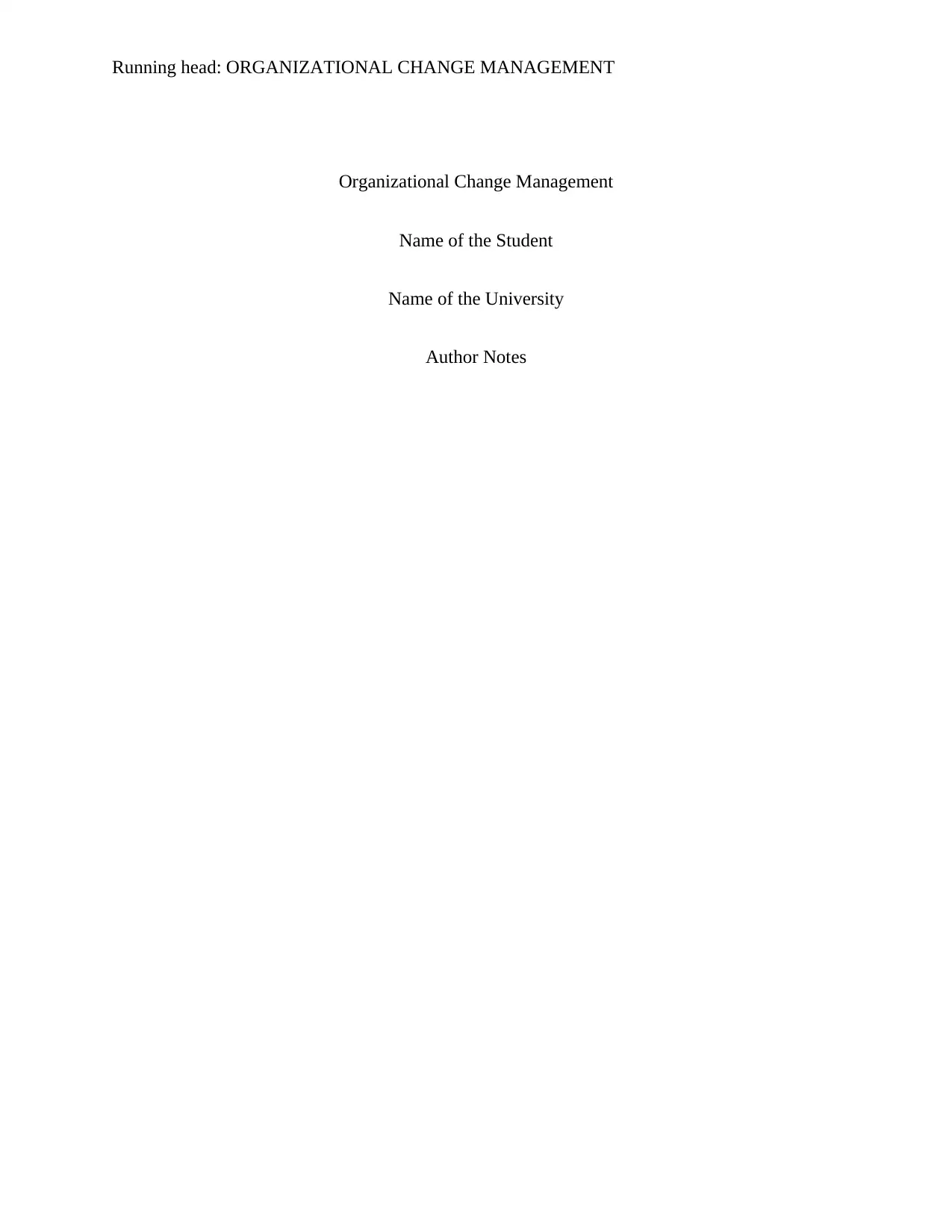
Running head: ORGANIZATIONAL CHANGE MANAGEMENT
Organizational Change Management
Name of the Student
Name of the University
Author Notes
Organizational Change Management
Name of the Student
Name of the University
Author Notes
Paraphrase This Document
Need a fresh take? Get an instant paraphrase of this document with our AI Paraphraser
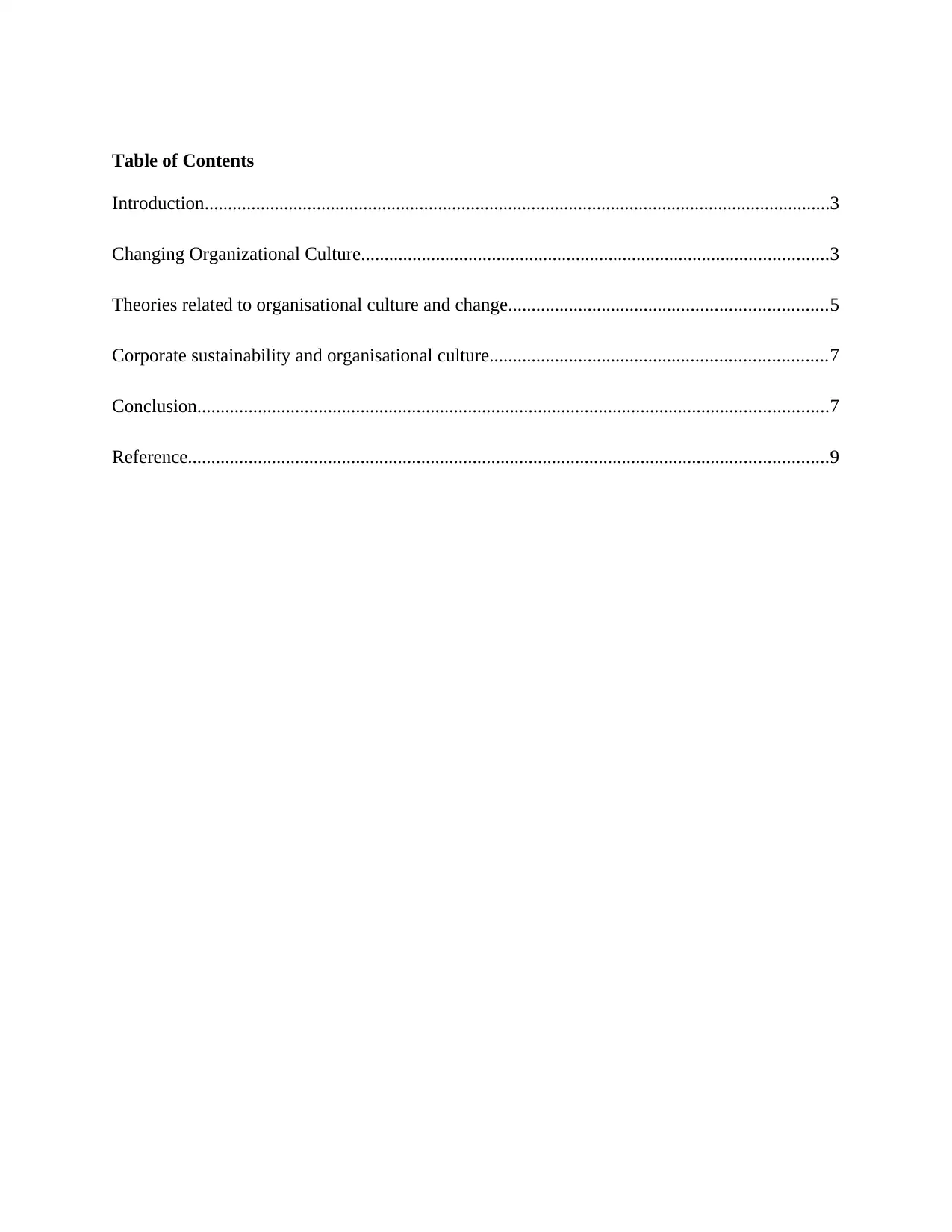
Table of Contents
Introduction......................................................................................................................................3
Changing Organizational Culture....................................................................................................3
Theories related to organisational culture and change....................................................................5
Corporate sustainability and organisational culture........................................................................7
Conclusion.......................................................................................................................................7
Reference.........................................................................................................................................9
Introduction......................................................................................................................................3
Changing Organizational Culture....................................................................................................3
Theories related to organisational culture and change....................................................................5
Corporate sustainability and organisational culture........................................................................7
Conclusion.......................................................................................................................................7
Reference.........................................................................................................................................9
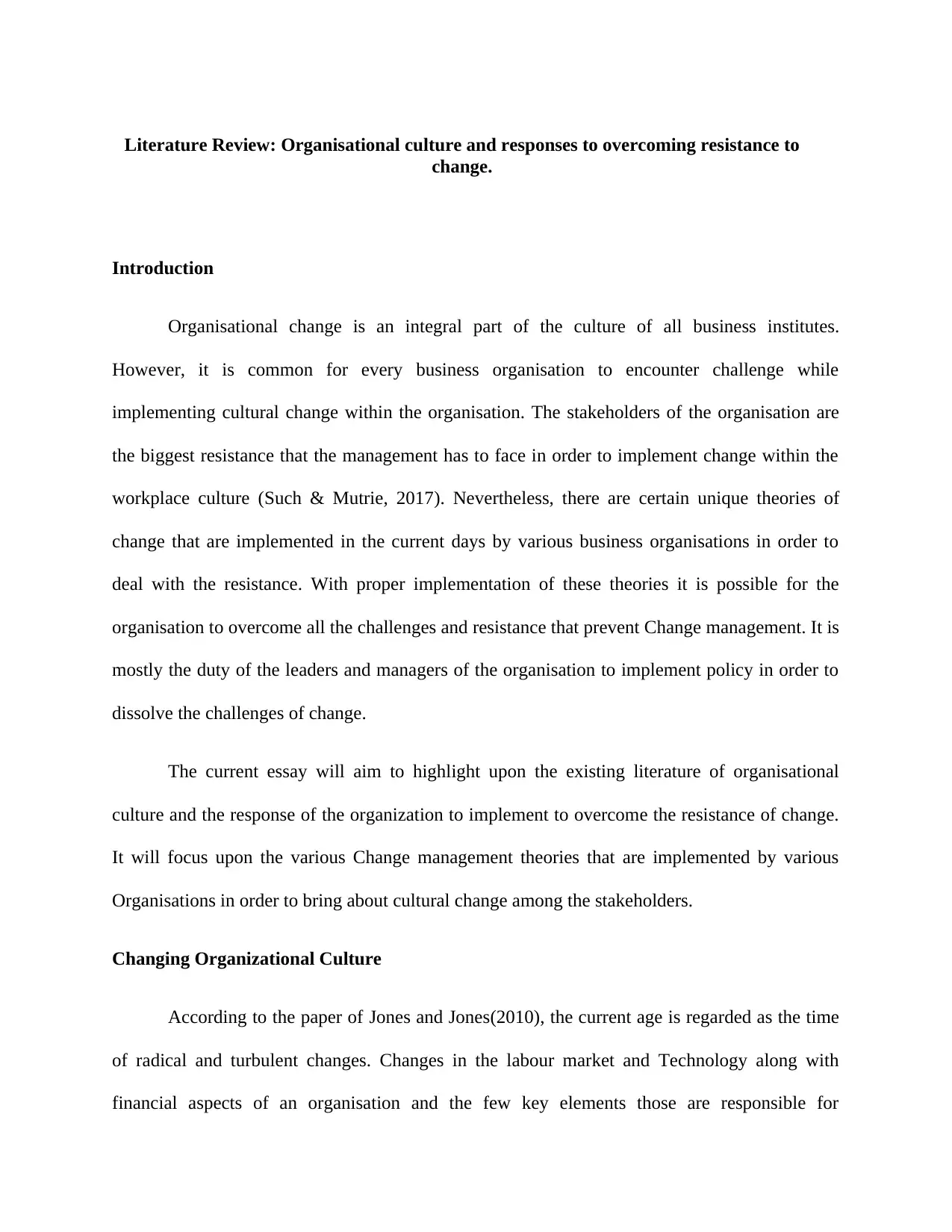
Literature Review: Organisational culture and responses to overcoming resistance to
change.
Introduction
Organisational change is an integral part of the culture of all business institutes.
However, it is common for every business organisation to encounter challenge while
implementing cultural change within the organisation. The stakeholders of the organisation are
the biggest resistance that the management has to face in order to implement change within the
workplace culture (Such & Mutrie, 2017). Nevertheless, there are certain unique theories of
change that are implemented in the current days by various business organisations in order to
deal with the resistance. With proper implementation of these theories it is possible for the
organisation to overcome all the challenges and resistance that prevent Change management. It is
mostly the duty of the leaders and managers of the organisation to implement policy in order to
dissolve the challenges of change.
The current essay will aim to highlight upon the existing literature of organisational
culture and the response of the organization to implement to overcome the resistance of change.
It will focus upon the various Change management theories that are implemented by various
Organisations in order to bring about cultural change among the stakeholders.
Changing Organizational Culture
According to the paper of Jones and Jones(2010), the current age is regarded as the time
of radical and turbulent changes. Changes in the labour market and Technology along with
financial aspects of an organisation and the few key elements those are responsible for
change.
Introduction
Organisational change is an integral part of the culture of all business institutes.
However, it is common for every business organisation to encounter challenge while
implementing cultural change within the organisation. The stakeholders of the organisation are
the biggest resistance that the management has to face in order to implement change within the
workplace culture (Such & Mutrie, 2017). Nevertheless, there are certain unique theories of
change that are implemented in the current days by various business organisations in order to
deal with the resistance. With proper implementation of these theories it is possible for the
organisation to overcome all the challenges and resistance that prevent Change management. It is
mostly the duty of the leaders and managers of the organisation to implement policy in order to
dissolve the challenges of change.
The current essay will aim to highlight upon the existing literature of organisational
culture and the response of the organization to implement to overcome the resistance of change.
It will focus upon the various Change management theories that are implemented by various
Organisations in order to bring about cultural change among the stakeholders.
Changing Organizational Culture
According to the paper of Jones and Jones(2010), the current age is regarded as the time
of radical and turbulent changes. Changes in the labour market and Technology along with
financial aspects of an organisation and the few key elements those are responsible for
⊘ This is a preview!⊘
Do you want full access?
Subscribe today to unlock all pages.

Trusted by 1+ million students worldwide
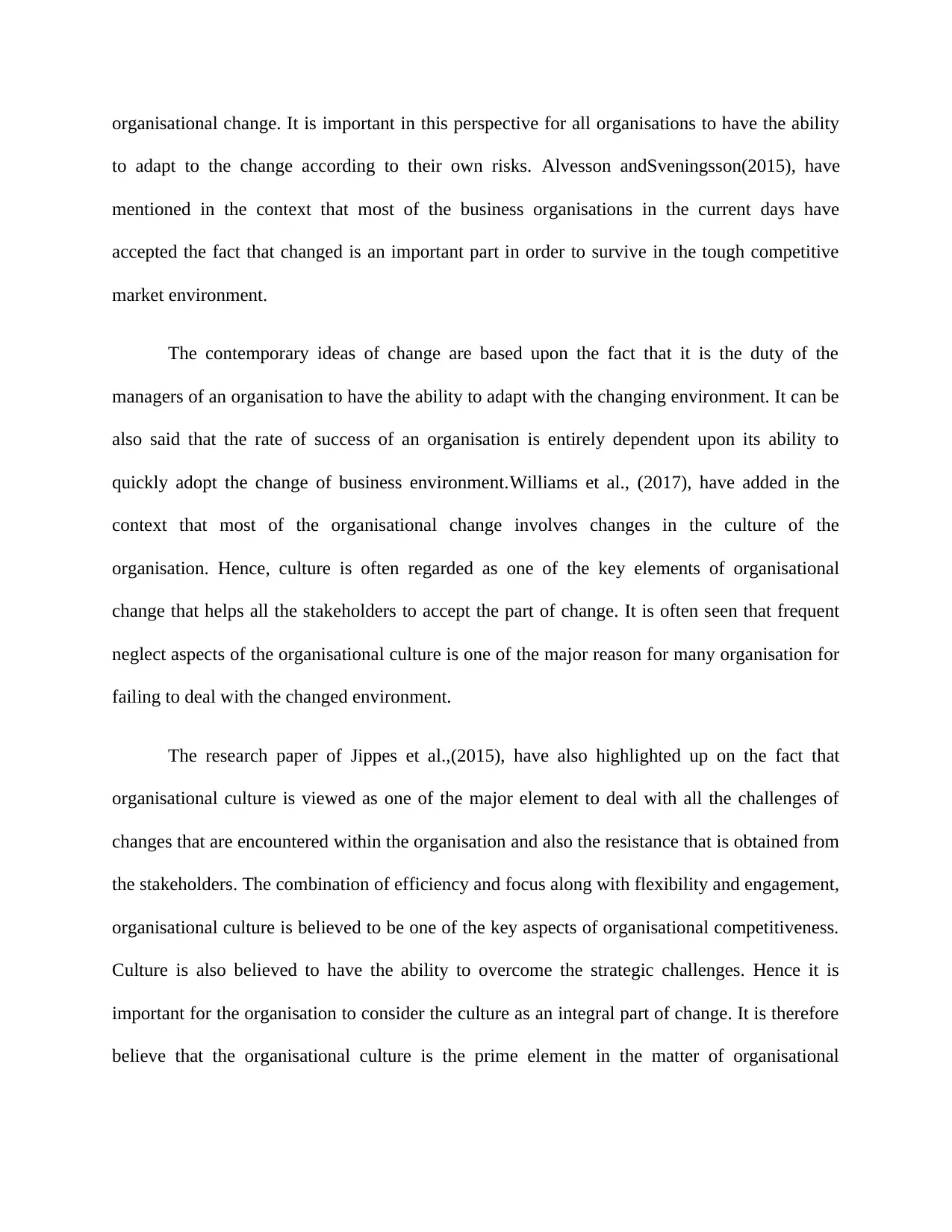
organisational change. It is important in this perspective for all organisations to have the ability
to adapt to the change according to their own risks. Alvesson andSveningsson(2015), have
mentioned in the context that most of the business organisations in the current days have
accepted the fact that changed is an important part in order to survive in the tough competitive
market environment.
The contemporary ideas of change are based upon the fact that it is the duty of the
managers of an organisation to have the ability to adapt with the changing environment. It can be
also said that the rate of success of an organisation is entirely dependent upon its ability to
quickly adopt the change of business environment.Williams et al., (2017), have added in the
context that most of the organisational change involves changes in the culture of the
organisation. Hence, culture is often regarded as one of the key elements of organisational
change that helps all the stakeholders to accept the part of change. It is often seen that frequent
neglect aspects of the organisational culture is one of the major reason for many organisation for
failing to deal with the changed environment.
The research paper of Jippes et al.,(2015), have also highlighted up on the fact that
organisational culture is viewed as one of the major element to deal with all the challenges of
changes that are encountered within the organisation and also the resistance that is obtained from
the stakeholders. The combination of efficiency and focus along with flexibility and engagement,
organisational culture is believed to be one of the key aspects of organisational competitiveness.
Culture is also believed to have the ability to overcome the strategic challenges. Hence it is
important for the organisation to consider the culture as an integral part of change. It is therefore
believe that the organisational culture is the prime element in the matter of organisational
to adapt to the change according to their own risks. Alvesson andSveningsson(2015), have
mentioned in the context that most of the business organisations in the current days have
accepted the fact that changed is an important part in order to survive in the tough competitive
market environment.
The contemporary ideas of change are based upon the fact that it is the duty of the
managers of an organisation to have the ability to adapt with the changing environment. It can be
also said that the rate of success of an organisation is entirely dependent upon its ability to
quickly adopt the change of business environment.Williams et al., (2017), have added in the
context that most of the organisational change involves changes in the culture of the
organisation. Hence, culture is often regarded as one of the key elements of organisational
change that helps all the stakeholders to accept the part of change. It is often seen that frequent
neglect aspects of the organisational culture is one of the major reason for many organisation for
failing to deal with the changed environment.
The research paper of Jippes et al.,(2015), have also highlighted up on the fact that
organisational culture is viewed as one of the major element to deal with all the challenges of
changes that are encountered within the organisation and also the resistance that is obtained from
the stakeholders. The combination of efficiency and focus along with flexibility and engagement,
organisational culture is believed to be one of the key aspects of organisational competitiveness.
Culture is also believed to have the ability to overcome the strategic challenges. Hence it is
important for the organisation to consider the culture as an integral part of change. It is therefore
believe that the organisational culture is the prime element in the matter of organisational
Paraphrase This Document
Need a fresh take? Get an instant paraphrase of this document with our AI Paraphraser
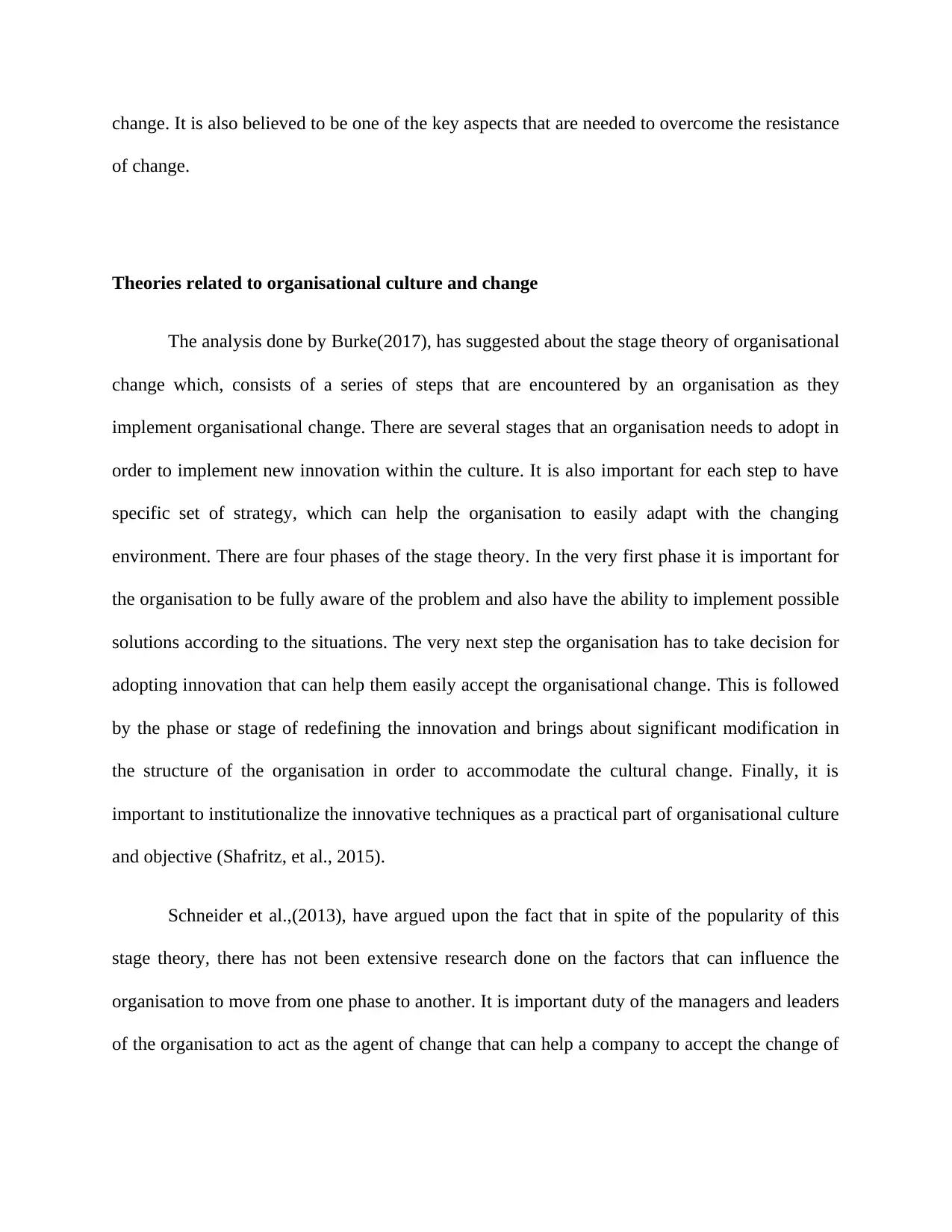
change. It is also believed to be one of the key aspects that are needed to overcome the resistance
of change.
Theories related to organisational culture and change
The analysis done by Burke(2017), has suggested about the stage theory of organisational
change which, consists of a series of steps that are encountered by an organisation as they
implement organisational change. There are several stages that an organisation needs to adopt in
order to implement new innovation within the culture. It is also important for each step to have
specific set of strategy, which can help the organisation to easily adapt with the changing
environment. There are four phases of the stage theory. In the very first phase it is important for
the organisation to be fully aware of the problem and also have the ability to implement possible
solutions according to the situations. The very next step the organisation has to take decision for
adopting innovation that can help them easily accept the organisational change. This is followed
by the phase or stage of redefining the innovation and brings about significant modification in
the structure of the organisation in order to accommodate the cultural change. Finally, it is
important to institutionalize the innovative techniques as a practical part of organisational culture
and objective (Shafritz, et al., 2015).
Schneider et al.,(2013), have argued upon the fact that in spite of the popularity of this
stage theory, there has not been extensive research done on the factors that can influence the
organisation to move from one phase to another. It is important duty of the managers and leaders
of the organisation to act as the agent of change that can help a company to accept the change of
of change.
Theories related to organisational culture and change
The analysis done by Burke(2017), has suggested about the stage theory of organisational
change which, consists of a series of steps that are encountered by an organisation as they
implement organisational change. There are several stages that an organisation needs to adopt in
order to implement new innovation within the culture. It is also important for each step to have
specific set of strategy, which can help the organisation to easily adapt with the changing
environment. There are four phases of the stage theory. In the very first phase it is important for
the organisation to be fully aware of the problem and also have the ability to implement possible
solutions according to the situations. The very next step the organisation has to take decision for
adopting innovation that can help them easily accept the organisational change. This is followed
by the phase or stage of redefining the innovation and brings about significant modification in
the structure of the organisation in order to accommodate the cultural change. Finally, it is
important to institutionalize the innovative techniques as a practical part of organisational culture
and objective (Shafritz, et al., 2015).
Schneider et al.,(2013), have argued upon the fact that in spite of the popularity of this
stage theory, there has not been extensive research done on the factors that can influence the
organisation to move from one phase to another. It is important duty of the managers and leaders
of the organisation to act as the agent of change that can help a company to accept the change of
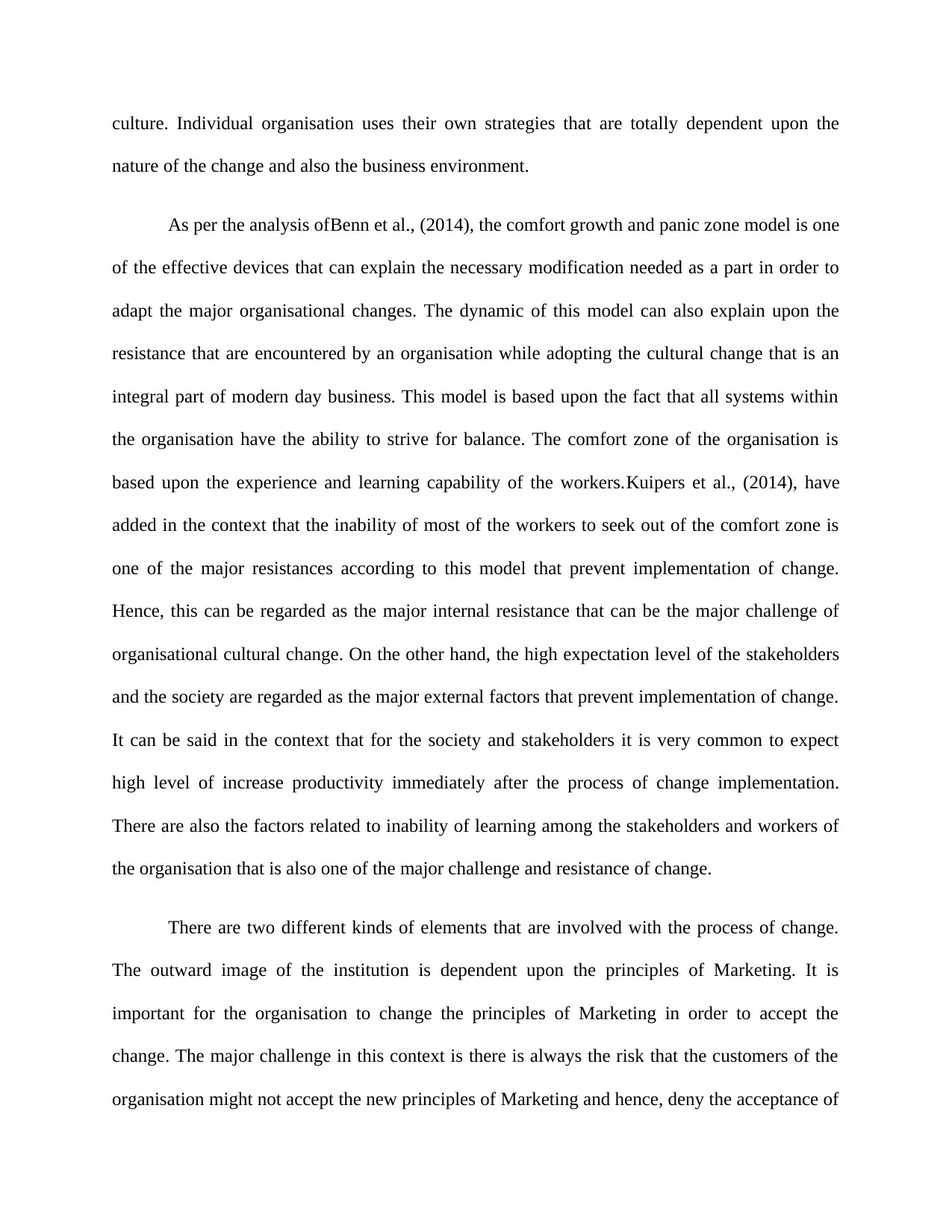
culture. Individual organisation uses their own strategies that are totally dependent upon the
nature of the change and also the business environment.
As per the analysis ofBenn et al., (2014), the comfort growth and panic zone model is one
of the effective devices that can explain the necessary modification needed as a part in order to
adapt the major organisational changes. The dynamic of this model can also explain upon the
resistance that are encountered by an organisation while adopting the cultural change that is an
integral part of modern day business. This model is based upon the fact that all systems within
the organisation have the ability to strive for balance. The comfort zone of the organisation is
based upon the experience and learning capability of the workers.Kuipers et al., (2014), have
added in the context that the inability of most of the workers to seek out of the comfort zone is
one of the major resistances according to this model that prevent implementation of change.
Hence, this can be regarded as the major internal resistance that can be the major challenge of
organisational cultural change. On the other hand, the high expectation level of the stakeholders
and the society are regarded as the major external factors that prevent implementation of change.
It can be said in the context that for the society and stakeholders it is very common to expect
high level of increase productivity immediately after the process of change implementation.
There are also the factors related to inability of learning among the stakeholders and workers of
the organisation that is also one of the major challenge and resistance of change.
There are two different kinds of elements that are involved with the process of change.
The outward image of the institution is dependent upon the principles of Marketing. It is
important for the organisation to change the principles of Marketing in order to accept the
change. The major challenge in this context is there is always the risk that the customers of the
organisation might not accept the new principles of Marketing and hence, deny the acceptance of
nature of the change and also the business environment.
As per the analysis ofBenn et al., (2014), the comfort growth and panic zone model is one
of the effective devices that can explain the necessary modification needed as a part in order to
adapt the major organisational changes. The dynamic of this model can also explain upon the
resistance that are encountered by an organisation while adopting the cultural change that is an
integral part of modern day business. This model is based upon the fact that all systems within
the organisation have the ability to strive for balance. The comfort zone of the organisation is
based upon the experience and learning capability of the workers.Kuipers et al., (2014), have
added in the context that the inability of most of the workers to seek out of the comfort zone is
one of the major resistances according to this model that prevent implementation of change.
Hence, this can be regarded as the major internal resistance that can be the major challenge of
organisational cultural change. On the other hand, the high expectation level of the stakeholders
and the society are regarded as the major external factors that prevent implementation of change.
It can be said in the context that for the society and stakeholders it is very common to expect
high level of increase productivity immediately after the process of change implementation.
There are also the factors related to inability of learning among the stakeholders and workers of
the organisation that is also one of the major challenge and resistance of change.
There are two different kinds of elements that are involved with the process of change.
The outward image of the institution is dependent upon the principles of Marketing. It is
important for the organisation to change the principles of Marketing in order to accept the
change. The major challenge in this context is there is always the risk that the customers of the
organisation might not accept the new principles of Marketing and hence, deny the acceptance of
⊘ This is a preview!⊘
Do you want full access?
Subscribe today to unlock all pages.

Trusted by 1+ million students worldwide
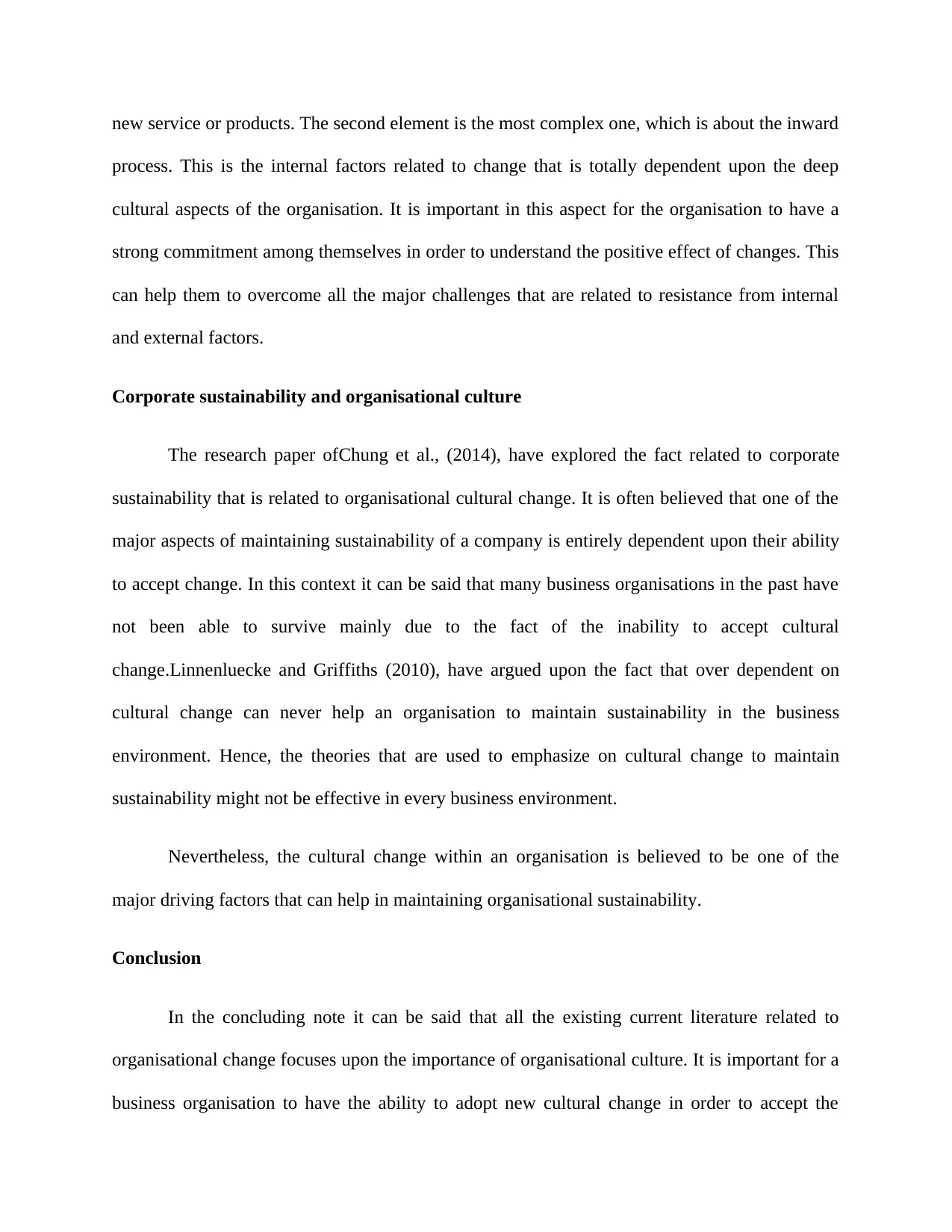
new service or products. The second element is the most complex one, which is about the inward
process. This is the internal factors related to change that is totally dependent upon the deep
cultural aspects of the organisation. It is important in this aspect for the organisation to have a
strong commitment among themselves in order to understand the positive effect of changes. This
can help them to overcome all the major challenges that are related to resistance from internal
and external factors.
Corporate sustainability and organisational culture
The research paper ofChung et al., (2014), have explored the fact related to corporate
sustainability that is related to organisational cultural change. It is often believed that one of the
major aspects of maintaining sustainability of a company is entirely dependent upon their ability
to accept change. In this context it can be said that many business organisations in the past have
not been able to survive mainly due to the fact of the inability to accept cultural
change.Linnenluecke and Griffiths (2010), have argued upon the fact that over dependent on
cultural change can never help an organisation to maintain sustainability in the business
environment. Hence, the theories that are used to emphasize on cultural change to maintain
sustainability might not be effective in every business environment.
Nevertheless, the cultural change within an organisation is believed to be one of the
major driving factors that can help in maintaining organisational sustainability.
Conclusion
In the concluding note it can be said that all the existing current literature related to
organisational change focuses upon the importance of organisational culture. It is important for a
business organisation to have the ability to adopt new cultural change in order to accept the
process. This is the internal factors related to change that is totally dependent upon the deep
cultural aspects of the organisation. It is important in this aspect for the organisation to have a
strong commitment among themselves in order to understand the positive effect of changes. This
can help them to overcome all the major challenges that are related to resistance from internal
and external factors.
Corporate sustainability and organisational culture
The research paper ofChung et al., (2014), have explored the fact related to corporate
sustainability that is related to organisational cultural change. It is often believed that one of the
major aspects of maintaining sustainability of a company is entirely dependent upon their ability
to accept change. In this context it can be said that many business organisations in the past have
not been able to survive mainly due to the fact of the inability to accept cultural
change.Linnenluecke and Griffiths (2010), have argued upon the fact that over dependent on
cultural change can never help an organisation to maintain sustainability in the business
environment. Hence, the theories that are used to emphasize on cultural change to maintain
sustainability might not be effective in every business environment.
Nevertheless, the cultural change within an organisation is believed to be one of the
major driving factors that can help in maintaining organisational sustainability.
Conclusion
In the concluding note it can be said that all the existing current literature related to
organisational change focuses upon the importance of organisational culture. It is important for a
business organisation to have the ability to adopt new cultural change in order to accept the
Paraphrase This Document
Need a fresh take? Get an instant paraphrase of this document with our AI Paraphraser
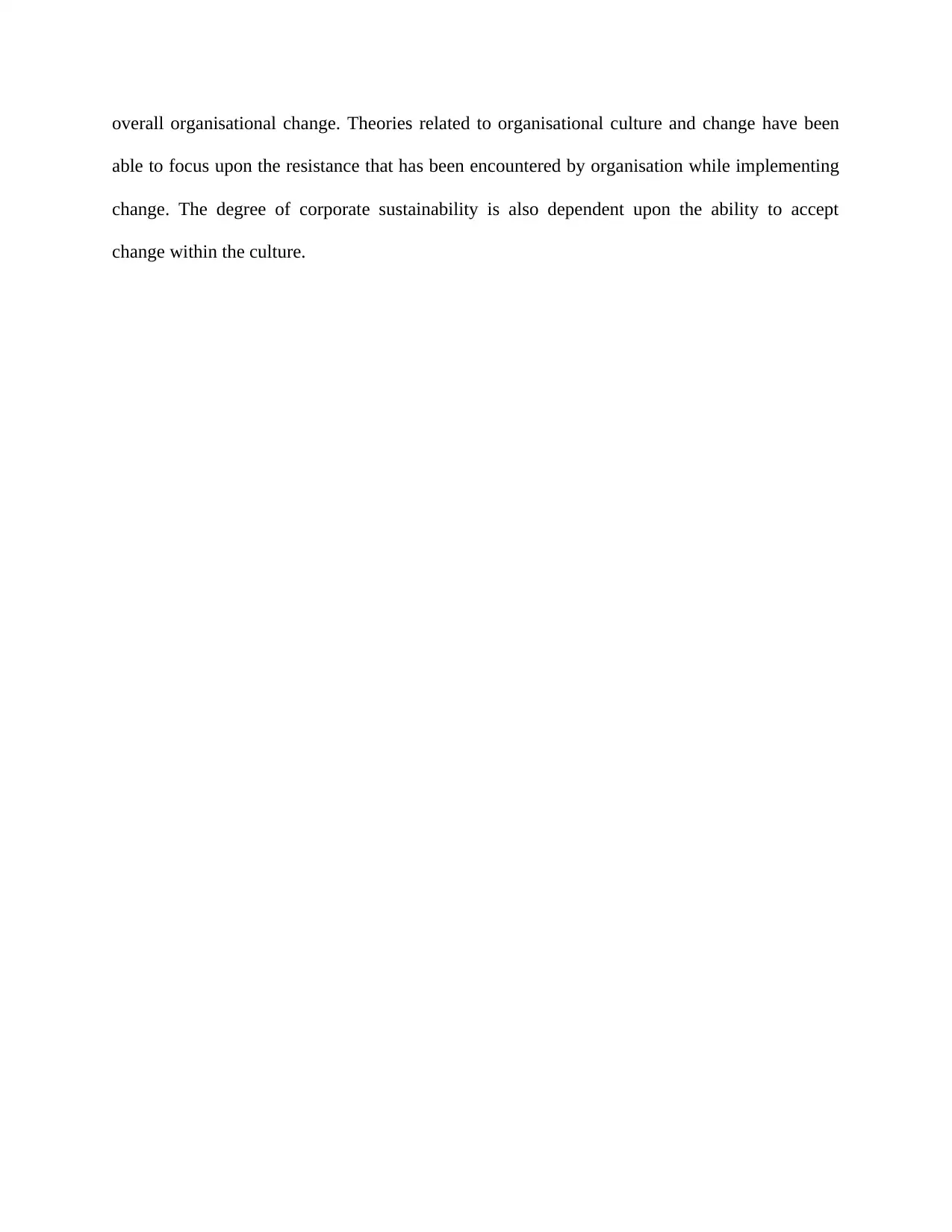
overall organisational change. Theories related to organisational culture and change have been
able to focus upon the resistance that has been encountered by organisation while implementing
change. The degree of corporate sustainability is also dependent upon the ability to accept
change within the culture.
able to focus upon the resistance that has been encountered by organisation while implementing
change. The degree of corporate sustainability is also dependent upon the ability to accept
change within the culture.
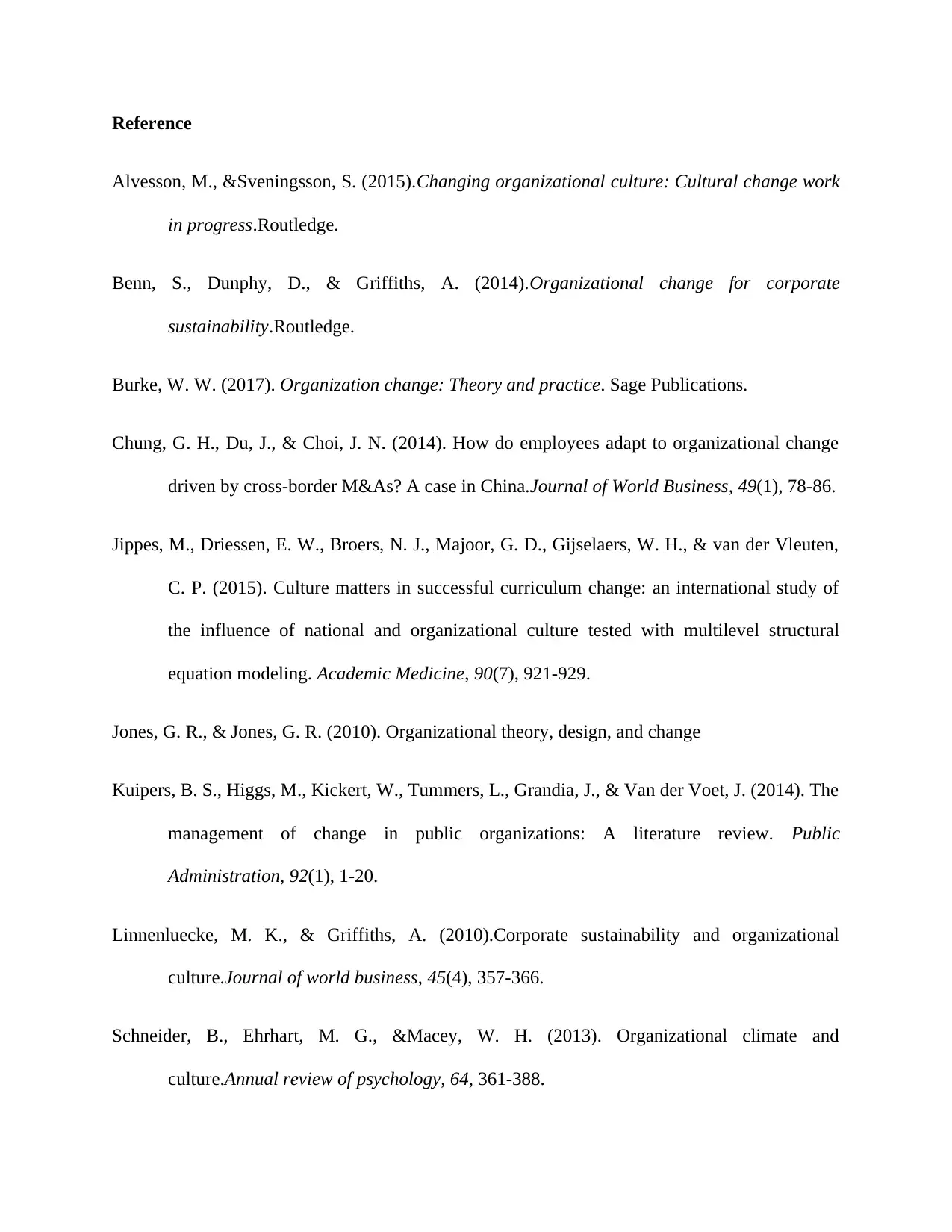
Reference
Alvesson, M., &Sveningsson, S. (2015).Changing organizational culture: Cultural change work
in progress.Routledge.
Benn, S., Dunphy, D., & Griffiths, A. (2014).Organizational change for corporate
sustainability.Routledge.
Burke, W. W. (2017). Organization change: Theory and practice. Sage Publications.
Chung, G. H., Du, J., & Choi, J. N. (2014). How do employees adapt to organizational change
driven by cross-border M&As? A case in China.Journal of World Business, 49(1), 78-86.
Jippes, M., Driessen, E. W., Broers, N. J., Majoor, G. D., Gijselaers, W. H., & van der Vleuten,
C. P. (2015). Culture matters in successful curriculum change: an international study of
the influence of national and organizational culture tested with multilevel structural
equation modeling. Academic Medicine, 90(7), 921-929.
Jones, G. R., & Jones, G. R. (2010). Organizational theory, design, and change
Kuipers, B. S., Higgs, M., Kickert, W., Tummers, L., Grandia, J., & Van der Voet, J. (2014). The
management of change in public organizations: A literature review. Public
Administration, 92(1), 1-20.
Linnenluecke, M. K., & Griffiths, A. (2010).Corporate sustainability and organizational
culture.Journal of world business, 45(4), 357-366.
Schneider, B., Ehrhart, M. G., &Macey, W. H. (2013). Organizational climate and
culture.Annual review of psychology, 64, 361-388.
Alvesson, M., &Sveningsson, S. (2015).Changing organizational culture: Cultural change work
in progress.Routledge.
Benn, S., Dunphy, D., & Griffiths, A. (2014).Organizational change for corporate
sustainability.Routledge.
Burke, W. W. (2017). Organization change: Theory and practice. Sage Publications.
Chung, G. H., Du, J., & Choi, J. N. (2014). How do employees adapt to organizational change
driven by cross-border M&As? A case in China.Journal of World Business, 49(1), 78-86.
Jippes, M., Driessen, E. W., Broers, N. J., Majoor, G. D., Gijselaers, W. H., & van der Vleuten,
C. P. (2015). Culture matters in successful curriculum change: an international study of
the influence of national and organizational culture tested with multilevel structural
equation modeling. Academic Medicine, 90(7), 921-929.
Jones, G. R., & Jones, G. R. (2010). Organizational theory, design, and change
Kuipers, B. S., Higgs, M., Kickert, W., Tummers, L., Grandia, J., & Van der Voet, J. (2014). The
management of change in public organizations: A literature review. Public
Administration, 92(1), 1-20.
Linnenluecke, M. K., & Griffiths, A. (2010).Corporate sustainability and organizational
culture.Journal of world business, 45(4), 357-366.
Schneider, B., Ehrhart, M. G., &Macey, W. H. (2013). Organizational climate and
culture.Annual review of psychology, 64, 361-388.
⊘ This is a preview!⊘
Do you want full access?
Subscribe today to unlock all pages.

Trusted by 1+ million students worldwide
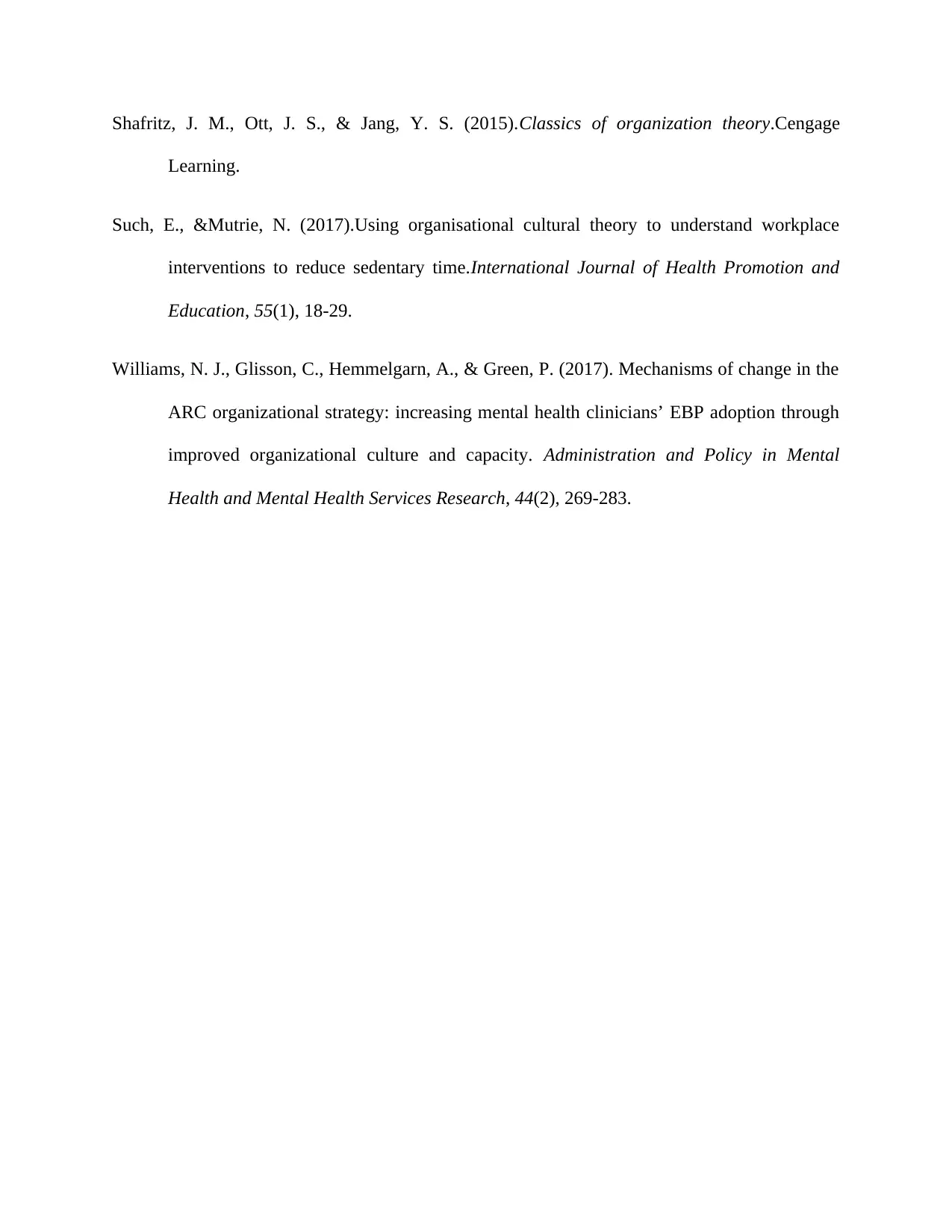
Shafritz, J. M., Ott, J. S., & Jang, Y. S. (2015).Classics of organization theory.Cengage
Learning.
Such, E., &Mutrie, N. (2017).Using organisational cultural theory to understand workplace
interventions to reduce sedentary time.International Journal of Health Promotion and
Education, 55(1), 18-29.
Williams, N. J., Glisson, C., Hemmelgarn, A., & Green, P. (2017). Mechanisms of change in the
ARC organizational strategy: increasing mental health clinicians’ EBP adoption through
improved organizational culture and capacity. Administration and Policy in Mental
Health and Mental Health Services Research, 44(2), 269-283.
Learning.
Such, E., &Mutrie, N. (2017).Using organisational cultural theory to understand workplace
interventions to reduce sedentary time.International Journal of Health Promotion and
Education, 55(1), 18-29.
Williams, N. J., Glisson, C., Hemmelgarn, A., & Green, P. (2017). Mechanisms of change in the
ARC organizational strategy: increasing mental health clinicians’ EBP adoption through
improved organizational culture and capacity. Administration and Policy in Mental
Health and Mental Health Services Research, 44(2), 269-283.
1 out of 10
Related Documents
Your All-in-One AI-Powered Toolkit for Academic Success.
+13062052269
info@desklib.com
Available 24*7 on WhatsApp / Email
![[object Object]](/_next/static/media/star-bottom.7253800d.svg)
Unlock your academic potential
Copyright © 2020–2025 A2Z Services. All Rights Reserved. Developed and managed by ZUCOL.





